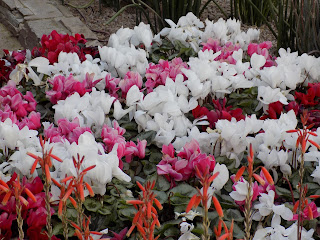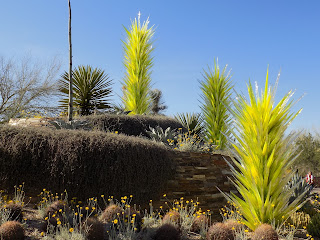Our first visit in Phoenix was to the Desert Botanical Garden. Started by volunteers in the 1930's, this amazingly beautiful garden occupies 140 acres. There are more than 21,000 plants with 1/3 being native to Arizona. There are 139 plants that are threatened or endangered. If you think you know what a cactus is, think again. We couldn't have picked a better March day to be at the garden. Everything was coming into bloom.
The garden is a beautiful spot to just sit back and relax.
Next stop was the Heard Museum where the art of Native Americans is on display. Not just ancient art including ancestral artifacts and 500 Hopi katsina dolls but modern extraordinary examples of what is being done today. The Heard has over 40,000 objects with 12 showcases.
Although the ancient art was interesting, the art produced by the modern day artists was simply amazing.
Our final stop was Taliesin West, Frank Lloyd Wright's winter home and architectural studio. Frank Lloyd Wright was enamored with the beauty and inspiration of the desert. He created one of his most personal designs in Taliesin West. He and his apprentices literally built Taliesin West out of the stone and sand of McDowell mountains. Some of the apprentices who worked with Wright still live there as do the current students and faculty. It still operates as a School of Architecture. I was amazed by the materials they used to build Taliesen. When looked at from a distance, it looks like fine redwoods and mahogany but is really painted plywood. Having said that, I would still want to live there. Just take a look ......
The lines, curves, right angles, the overpowering simplicity. Spectacular...............
Next, California, here we come....
Still in Arizona, we headed to a National Monument called Tumacacori. Pronounced just like it is spelled (Tuma-ca-cori). Located south of Tuscan, was a Pima indian settlement. Built in approximately 1701 by Spanish Jesuits, the mission was constructed as much for protection as religious reasons. In 1767, King Charles III of Spain, for political reasons, banished all Jesuits from the realm and replaced them with the Franciscans who took over the missionary effort. About 1800, Fray Narciso Gutierrez began to build a church to replace the modest Jesuit structure. The poverty and Mexican revolution slowed construction. With Mexican independence, the last Spanish priest had to leave, ending the 157 year thread of continuity. The last residents left Tumacacori in 1848 and the land was purchased as part of the Gadsden Purchase and became part of the U.S.
This photo is a representation of what the church looked like when it was in operation.
Beautiful colors in the midst of the desert. The National Park decided to keep the monument in situ or in the same state it was found when it was purchased by the National Park System. There are several such sites around the southwest.
Next stop was on the way to Phoenix. Casa Grande National Monument is not far off I-10 in the farming town of Coolidge, AZ. You drive down a two lane highway through farms and rural towns. As you drive through Coolidge, you look to the left and here is what you see.
Until we arrived at the visitor's center, we really couldn't tell what was what. As it turns out, the monument is the building created out of caliche that is the only ruin of a multi-story building constructed by the ancestral Sonoran Desert Indians. Built it about 1350 C.E., its purpose remains a mystery. These people built the Casa Grande developed wide-scale irrigation farming and extensive trade connections that lasted over a thousand years.
Here are the Cliff Notes. The
Casa Grande was abandoned around 1450 C.E. and the inhabitants left no written history behind. Written
historic accounts of the Casa Grande begin with the journal entries of Padre Eusebio Francisco Kino
when he visited the ruins in 1694. In his description of the large
ancient structure before him, he wrote the words "casa grande" (or
"great house") which are still used today. More became known about the
ruins with the later visits of Lt. Col. Juan Bautista de Anza's expedition in 1775 and Brig. Gen. Stephen Watts Kearny's
military detachment in 1846. Subsequent articles written about the Casa
Grande increased public interest. During the 1860's through the 1880's
more people began to visit the ruins with the arrival of a railroad line
twenty miles to the west and a connecting stagecoach route that ran
right by the Casa Grande. The resulting damage from souvenir hunting,
graffiti and outright vandalism raised serious concerns about the
preservation of the Casa Grande.
Several
important construction projects were undertaken during the 1930's. The
main part of the visitor center building with adjacent parking lot and
entrance road, and a new steel shelter roof over the Casa Grande, were
completed in 1932. Between 1937 and 1940, the Civilian Conservation Corps
constructed a number of adobe buildings to support park operations. All
of these structures remain in use today and are now listed on the
National Register of Historic Places. As a result, the general physical
appearance of Casa Grande Ruins has changed very little since the
1940's.
Next stop, Phoenix!
In 1938, my Dad went to Tucson and fell in love with the West. He loved the dry air of the desert, the exceptional flora, and the whole atmosphere. In 1951, he was offered a job in Tucson with Hughes Aviation. My mom and dad flew out to look for a place to live. It is one of my first clear memories. I watched them take off from Philadelphia airport in a TWA Constellation. Four props and three tails in red and white livery. Although they found a house, my Dad decided that it was too big of risk. It wasn't until our generation, that true career mobility occurred. We moved 11 times in our marriage and now live full time in an RV traveling. For them, however, it was a really big deal.
Although I had been to Tucson several times, we really got to see some sites in March of 2016. Mom and Dad found a house that was right on the edge of the Sajauro National Park so that is where we started. The park actually consists of two separate parks (one of the east side and one of the west side). We headed for the west side. As you begin to approach the park, you start seeing the sentinels of the desert.
A great visitor center with exhibits galore greets you and then off to the scenic Bajada Loop Drive that loops through a dense sajuaro forest. Heading back out we saw the first of thousands of cacti that we would see in our travels.
Next stop was the amazing Arizona Sonora Desert Museum. A combination zoo, botanical garden and museum. Everything you would ever want to know about the desert. The plant collection includes over 500 species of cactus and the variation is amazing.
And many species of animals as well.
What a fantastic place. If you are in the area, don't miss it.
Our next stop was the Asarco copper mine in Suhuarita, AZ. "Opened in February of 1997, the Asarco
Mineral Discovery Center is designed to convey the vital importance of
mining in our civilization. Everything that we use everyday was
somehow extracted from the earth — either by farming or by mining, and “if it can’t be grown, it has to be mined.”"
Not only is there an interesting center where you enter exhibits through a simulated ball mill, but guess what, you can take a guided tour of the mine.
The first stop on the tour is the Open-Pit Viewpoint on the south
rim of the Mission Mine. The Mission Mine is a quarter-mile deep, two miles from north to
south, and a mile-and-three-quarters from east to west. About six times
the amount of earth moved to dig the Panama Canal has been mined here.
 The Mission open-pit copper mine was at one time five separate mining
properties, but over the years, Asarco has combined them into one
integrated mining operation. The mine occupies around 20,000 acres of
private, State leased, and Indian land. As of July 2011 there were over
600 employees working three shifts, 24 hours a day, seven days a week. Each year the mine has the capacity to process about 260,000 tons of
copper concentrates which yields 132,700,000 pounds of copper and
1,234,000 ounces of silver.
The Mission open-pit copper mine was at one time five separate mining
properties, but over the years, Asarco has combined them into one
integrated mining operation. The mine occupies around 20,000 acres of
private, State leased, and Indian land. As of July 2011 there were over
600 employees working three shifts, 24 hours a day, seven days a week. Each year the mine has the capacity to process about 260,000 tons of
copper concentrates which yields 132,700,000 pounds of copper and
1,234,000 ounces of silver.
At the Mill, the copper ore is ground into a powder so the copper
minerals can be separated by the froth flotation process.
 These huge mills grind the ore into a fine powder
These huge mills grind the ore into a fine powder
so the copper minerals can be separated by flotation."
That little truck has tires that are ten feet tall and holds 400 tons. A really interesting day.
Next time, the National Monument with the unpronounceable name.



























































